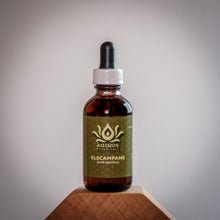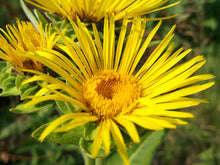Traditionally used to kill intestinal parasites, treat bronchial congestion, boost immune system, and tone stomach. Mainly used for the treatment of coughs, consumption and other pulmonary complaints, being a favourite domestic remedy for bronchitis.
Made with fresh-harvested roots.
Bottle: 50ml
-----------------------------------
Would you like to know more? Below you can find an excerpt from our book "Medicinal Perennials to Know and Grow"
Chiefly used for the treatment of coughs, consumption and other pulmonary complaints, Elecampane is a valuable medicine for all chronic diseases of the lungs including asthma and bronchitis. It has also been traditionally used to kill intestinal parasites, boost the immune system, and tone the stomach. Fresh, aromatic, roots are used to make this tincture.
Native to southern and central Europe, the Balkan Peninsula, and central Asia, this giant, robust herbaceous perennial grows from 6-10 feet. The soaring plant’s main stem and branches are topped from June to August with long slender, deep yellow ray flowers, projecting out from bright golden flower heads up to 4 inches in diameter. The large elliptical shaped leaves, green on top and fuzzy white on the underside, embrace the stem, becoming stalked towards the base, and can reach over a foot long.
This hardy plant can withstand variable growing conditions from partial shade to full sun and grows well in moist, ordinary garden soil, though it flourishes best in a rich loamy, damp but well-drained soil.
Sow seeds in the greenhouse in early spring or sow them directly in the garden around mid-spring. They are light-dependent germinators, so sow them on the surface or cover very shallowly, so that light can penetrate. Expect germination within 2 weeks. After the second set of leaves appear, seedlings can either be potted up or transplanted directly into the garden, even if a few frosts are still expected. Plants may also be propagated from root stock offsets, harvested in the autumn, over-wintered in pots, and planted out the following spring.
To save seeds, pluck them from the top of the spent flower heads and let them dry until the small dark seeds can be easily separated from their fluffy attachments.
The octopus-like roots are large, fleshy, and pleasingly aromatic. They are best harvested for their medicinal properties in the autumn of the second or third year of growth; after this, they tend to become woody.
Elecampane root has been used medicinally since Roman times. During the Middle Ages, apothecaries sold the candied root to soothe asthma and indigestion. Today, root preparations are used to stimulate digestion, kill intestinal parasites and soothe the stomach. It is an effective treatment for various pulmonary complaints including bronchial congestion and infection, consumption, asthma, and pneumonia. Elecampane also helps to boost the immune system and research has indicated that it is effective against methicillin-resistant staphylococcus aureus (MRSA).
For those looking for a great dye plant, Elecampane offers two distinct dyes: the root can be processed to yield a blue dye, and the flowers to yield a yellow/orange dye.






